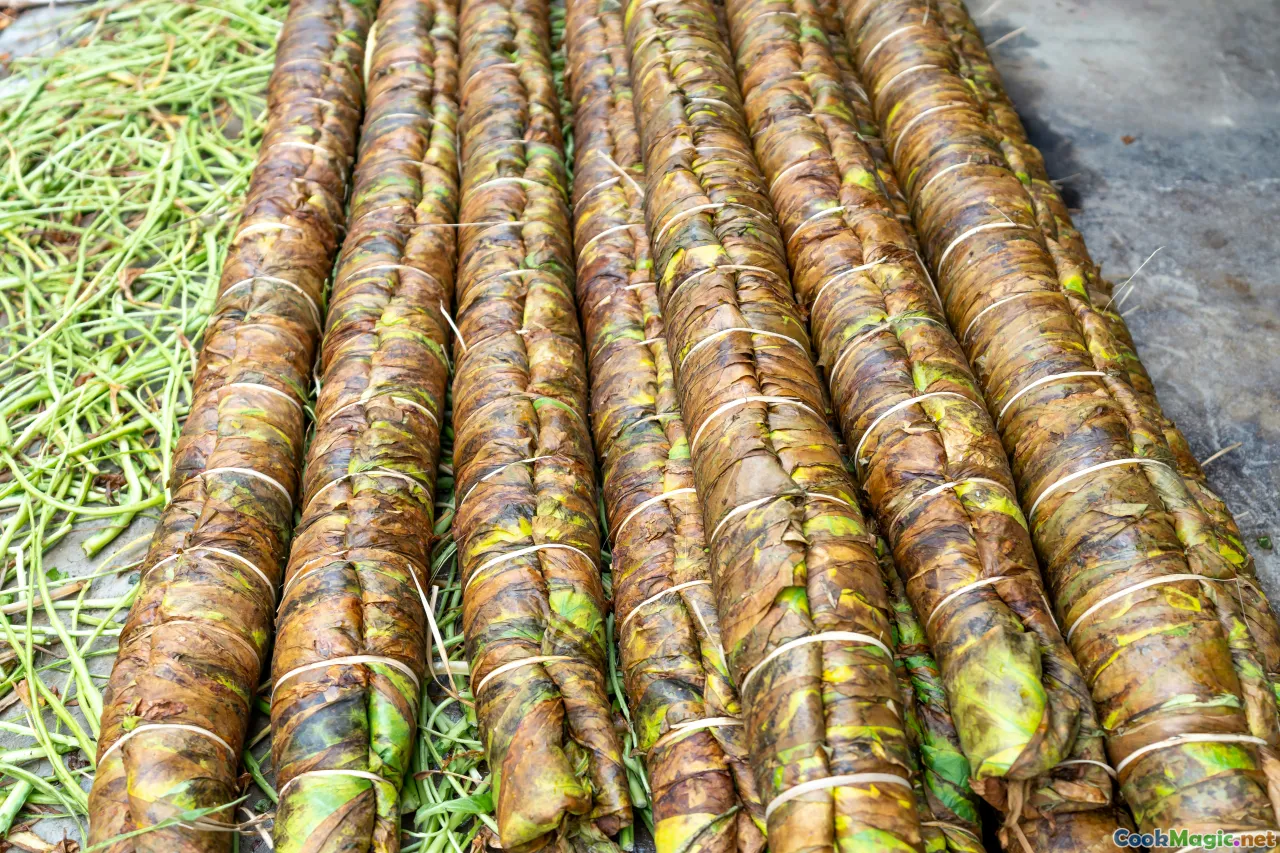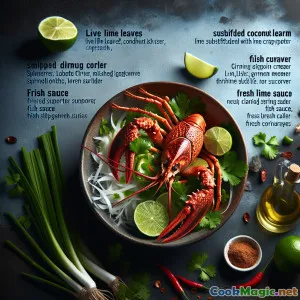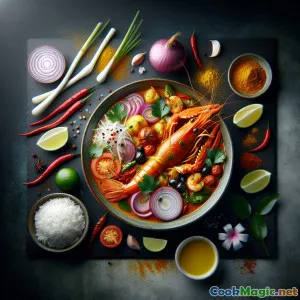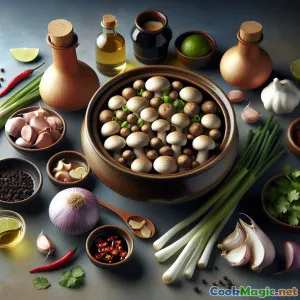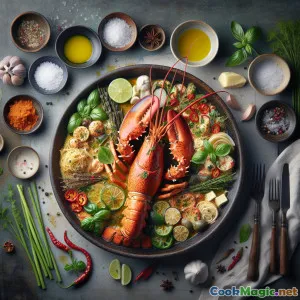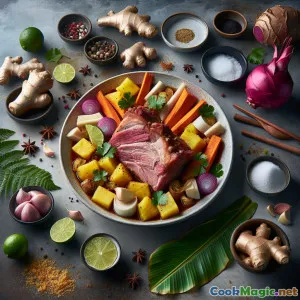
لحم خنزير مخبوز في حفرة بنكهات بابوا غينيا الجديدة
(Pit Baked Pork with Papua New Guinea Flavors)
(0 المراجعات)0
1,102
يوليو 19, 2025
الإبلاغ عن مشكلة
المكونات
-
2 kg كتف الخنزير مع العظم
(مُقَلَّم، ويفضَّل أن يكون مُربّى في مراعي حرة)
-
500 grams البطاطا الحلوة
(تقطيع مكعبات)
-
350 grams جذر التارو
(مقشّر ومفروم)
-
1 medium أناناس
(إزالة النواة وتقطيعها إلى مكعبات.)
-
6 whole أوراق الليمون
(طازج أو مجمد)
-
5 cm زنجبيل
(طازج، مبشور)
-
6 whole فصوص الثوم
(مطحون)
-
200 ml كريمة جوز الهند
(رجّه جيداً قبل الاستعمال)
-
2 tbsp ملح كوشير
-
1 tbsp فلفل أسود
(مطحون طازج)
-
4 large sheets أوراق الموز
(بطّن الحفرة أو صينية الخبز)
-
1 bunch الكزبرة الطازجة
(مُقطّع خشنًا، للتزيين)
-
1 tbsp سكر قصب السكر
(للحلاوة الخفيفة)
-
2 whole سيقان الليمون العشبي
(مَهْشُور)
(مُقَلَّم، ويفضَّل أن يكون مُربّى في مراعي حرة)
(تقطيع مكعبات)
(مقشّر ومفروم)
(إزالة النواة وتقطيعها إلى مكعبات.)
(طازج أو مجمد)
(طازج، مبشور)
(مطحون)
(رجّه جيداً قبل الاستعمال)
(مطحون طازج)
(بطّن الحفرة أو صينية الخبز)
(مُقطّع خشنًا، للتزيين)
(للحلاوة الخفيفة)
(مَهْشُور)
التغذية
- الحصص: 6
- حجم الحصة: حصة سخية واحدة (300 جم)
- Calories: 630 kcal
- Carbohydrates: 48 g
- Protein: 36 g
- Fat: 32 g
- Fiber: 7 g
- Sugar: 14 g
- Sodium: 1120 mg
- Cholesterol: 110 mg
- Calcium: 92 mg
- Iron: 3.1 mg
التعليمات
-
1 - جهّز الحفرة (أو الفرن):
إذا كان بالإمكان إنشاء حفرة تقليدية، فاحفر ثقباً بعمق نحو 600 مم، صفّه بالحجارة النهرية وأشعل ناراً من الخشب. سخّن الحجارة لمدة ساعة. وإلا، سخّن الفرن إلى 180°C (356°F) وافرش صينية خبز كبيرة بطبقة من أوراق الموز.
-
2 - تتبيل لحم الخنزير:
في وعاء كبير، اخلط الزنجبيل والثوم وكريمة جوز الهند والملح والفلفل الأسود وأوراق ليمون كافير، وسكر القصب (اختياري) وعشب الليمون. افركه جيداً في لحم الخنزير. اتركه يرتاح لمدة 20-30 دقيقة.
-
3 - تجميع الطبقات:
على أوراق الموز، ضع طبقة من التارو، البطاطا الحلوة، وقطع الأناناس. ضع لحم الخنزير المتبل في الأعلى، ورش باقي التتبيلة وبقايا أوراق الموز حولها.
-
4 - غلاف للخبز:
لف أوراق الموز حول المكونات بإحكام. ثبتها بالخيط أو بالفروع؛ إذا كنت ستستخدم الفرن، أضف طبقة إضافية من ورق الألومنيوم.
-
5 - ادفنه في الأرض واخبزه:
في الحفرة: ضع الحزمة على حجارة ساخنة، غطها بسخاء بالتربة والحجارة الساخنة لمدة 4 ساعات. في الفرن: اطبخها مغطاة لمدة 3-4 ساعات. قلبها في منتصف الطهي لضمان طهي متجانس.
-
6 - اللمسة الأخيرة والتقديم:
افتح أوراق الموز، تحقق من نعومة لحم الخنزير (يجب أن يكون طرياً بما يكفي ليُخترق بالشوكة). قطّع لحم الخنزير إلى شرائح، قدّمه فوق الخضار، وزينه بالكزبرة الطازجة.
إذا كان بالإمكان إنشاء حفرة تقليدية، فاحفر ثقباً بعمق نحو 600 مم، صفّه بالحجارة النهرية وأشعل ناراً من الخشب. سخّن الحجارة لمدة ساعة. وإلا، سخّن الفرن إلى 180°C (356°F) وافرش صينية خبز كبيرة بطبقة من أوراق الموز.
في وعاء كبير، اخلط الزنجبيل والثوم وكريمة جوز الهند والملح والفلفل الأسود وأوراق ليمون كافير، وسكر القصب (اختياري) وعشب الليمون. افركه جيداً في لحم الخنزير. اتركه يرتاح لمدة 20-30 دقيقة.
على أوراق الموز، ضع طبقة من التارو، البطاطا الحلوة، وقطع الأناناس. ضع لحم الخنزير المتبل في الأعلى، ورش باقي التتبيلة وبقايا أوراق الموز حولها.
لف أوراق الموز حول المكونات بإحكام. ثبتها بالخيط أو بالفروع؛ إذا كنت ستستخدم الفرن، أضف طبقة إضافية من ورق الألومنيوم.
في الحفرة: ضع الحزمة على حجارة ساخنة، غطها بسخاء بالتربة والحجارة الساخنة لمدة 4 ساعات. في الفرن: اطبخها مغطاة لمدة 3-4 ساعات. قلبها في منتصف الطهي لضمان طهي متجانس.
افتح أوراق الموز، تحقق من نعومة لحم الخنزير (يجب أن يكون طرياً بما يكفي ليُخترق بالشوكة). قطّع لحم الخنزير إلى شرائح، قدّمه فوق الخضار، وزينه بالكزبرة الطازجة.
المزيد عن : لحم خنزير مخبوز في حفرة بنكهات بابوا غينيا الجديدة
Mount Hagen Pit Baked Pork
Mount Hagen Pit Baked Pork is a culinary homage to the Earth oven (“mumu”) feasts deeply woven into Papua New Guinean highland life. Named after Mount Hagen—a fertile region humming with life, culture, and traditions—this impressive pork dish epitomizes communal feasting, respect for nature’s bounty, and indigenous inventiveness. Traditionally crafted for grand gatherings, the mumu not only cooks but transforms—the pork imbibes aromatic herbs and earthy essence through hours of gentle, pit-based steam-baking.
Origin & Cultural Significance
The concept of baking meat and tubers in earth pits predates written history and is celebrated throughout Oceania, including Hawaii’s ʻimu, New Zealand’s Māori hāngi, or the samurai earthen ovens of Japan. In Papua New Guinea, the mumu—named for the fashioning of hot stone-lined pits, layered with banana leaves—stands as a gastronomic and social centerpiece. Every aspect—stone selection, ingredient choice, fire and assembly order—is ceremonial, meant to foster kinship and celebrate shared bounty.
Mount Hagen, with its rolling, alluvial highlands, supplies earthy sweet potatoes (“kaukau”), starchy taros, and a whole spectrum of local greens, roots, and fruits. Pork remains especially prized, a marker of status and festivity—as well as economic wealth. Roasting it in a pit unleashes depths of flavor unattainable through modern means: fragrant steam perfumes flesh and vegetables while natural sugars caramelize against the hot stones.
Key Ingredients & Substitutions
The backbone of the dish is well-marbled pork shoulder or leg, marinated with an island blend of ginger, garlic, lime leaves, coconut cream, and hints of sugar cane. Locally, everything from ferns (“pitpit”) to wild greens and pandanus fruit may be included. When fresh banana leaves aren’t available, parchment paper and foil offer an urban compromise, though they cannot replicate the subtlety of roasted leaf aroma.
Fresh sweet potatoes and taro, both integral to the highland pantry, provide satisfying ballast and soak up pork drippings. Pineapple lends sweet acidity—a nod to the tropics’ abundant harvest. Coriander and lemongrass bring a freshness that cuts richness and aligns with regional flavor profiles. While pit-cooking imparts incomparable smokiness, an oven executed skillfully still delivers meltingly tender pork, steeped in savory-sweet juices.
Techniques, Tips & Notes
- If using a pit: Safety first—enlist help, be wary of hot stone placement, and tightly wrap that banana-leaf bundle!
- Oven method: Use ample banana leaves and double-wrap in foil to retain moisture before slow-roasting.
- Marinate as long as possible. At least 30 minutes infuses flavor but overnight is even better.
- Experiment: Slices of plantain, yams, or cassava give alternate root flavors. Spice the marinade with native bush pepper or hot chili if you wish.
- Smashing lemongrass stalks bruises their essential oils—don’t skip this step if you want citrusy undertones.
- Allow to rest post-baking before opening the parcel; this reabsorbs juices and ensures maximum savor.
History and Uniqueness
Mount Hagen itself hosts the famed cultural show—a gathering of tourists, tribes, and locals fiercely proud of their gastronomy. A ``pit baked pork'' centerpiece symbolizes hospitality, tradition, and ceremony. Visitors and home cooks alike are drawn to its harmony: lush vegetables, tropical fruits, the primal simplicity of fire, earth, and time fusing into nourishment.
With this recipe, urban kitchens can channel ancestral crafts while tucking into fork-tender pork, caramel-kissed vegetables, and savoring the magic born where nature, culture, and food converge. For the adventurous foodie, few dishes encapsulate such depth of place or purpose. Invite friends, cook together, play highland music, and serve with a side of warm storytelling—the essence of the Papua New Guinea mumu feast.
Personal thoughts: The Mount Hagen Pit Baked Pork is more than just a recipe—it’s an experience; a delicious taste of community, ceremony, and respect for the earth’s providence. Perfect for celebration, Sunday feasts, or any meal where food becomes a story.


